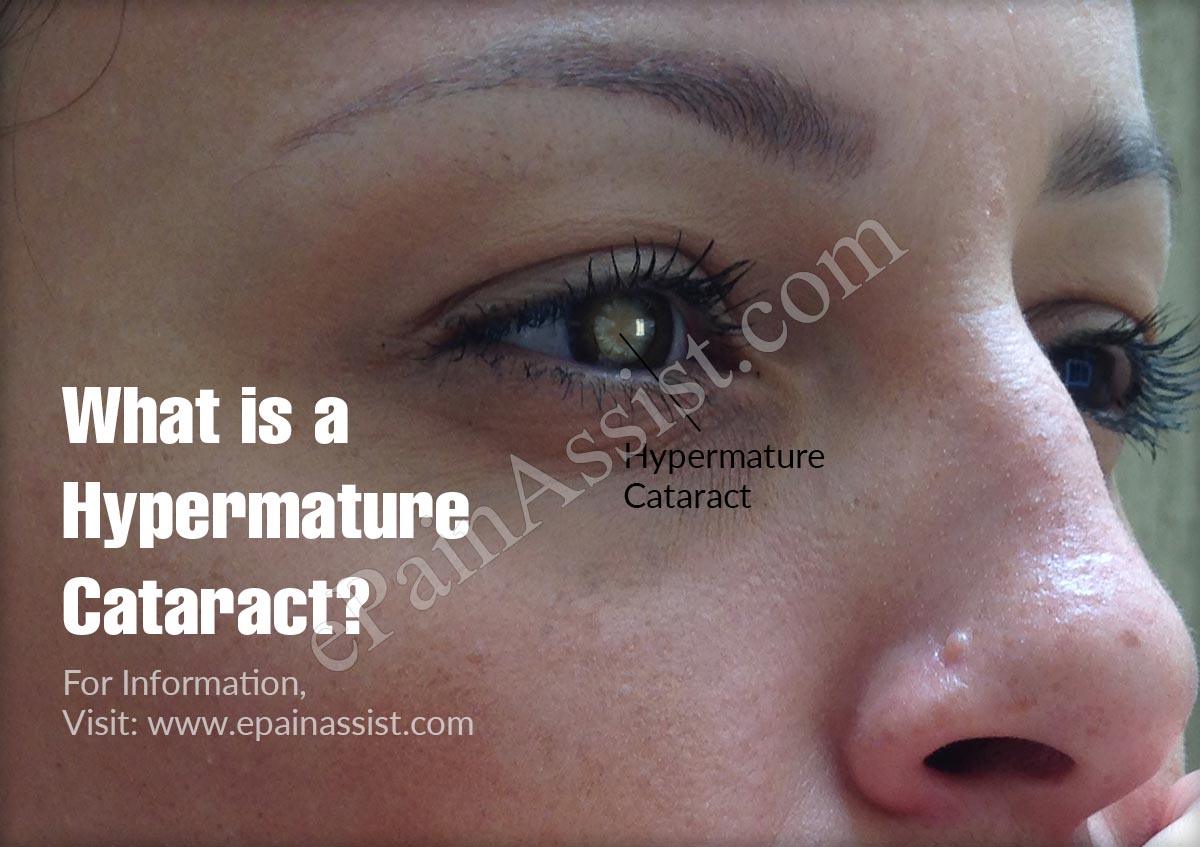What is a Hypermature Cataract?
Hypermature cataract is a special type of cataract that occurs when a mature senile cataract is left in-situ for some duration of time due to this the stage of hypermaturity sets in. Before defining hypermature cataract one should be clear about mature senile cataract.
A mature senile cataract is that stage where the opacification of the whole lens is present. The lens is pearly white in color and is also referred as Ripe Cataract. This opacification involves biochemical mechanisms like there is decrease in the crystalline lens proteins, potassium and various amino acids while there is increment in the concentration of sodium which leads to marked hydration of the lens leading to denaturation of lens proteins. When this form of MSC remains as it is for some time in the eye it becomes hypermature cataract.

Hypermature cataract basically is generally of two types:
Morgagnian Hypermature Cataract: In few cases the maturity of whole cortex liquefies and the lens is converted into a bag of milky fluid. The nucleus appears brown in color, becomes smaller and settles down at the bottom due to this the position of the nucleus is altered whenever there is change in the position of the lens.
Rarely in the morgagnian cataract there might be calcium deposition on the lens matter.
Sclerotic Type Hypermature Cataract: In this case after the stage of mature senile cataract the cortex becomes degenerated and the lens is shrunken because of the leakage of water from it. The anterior capsule appears wrinkled and there is a thickening present as there is proliferation of anterior cells, due to this a dense white capsular cataract may be formed in the pupillary area. Due to the shrunken lens the anterior chamber becomes deeper than normal and there is presence of iridodonesis (there are tremors in the iris).
Clinical Features of Hypermature Cataract
Symptoms
The symptoms seen are similar to normal mature senile cataract. These are discussed in brief.
Glare – One of the earliest symptoms seen. In this the person is intolerant of bright light like a headlight or directly staring at sunlight precipitates this.
Polyopia – It is unilocular in nature. Polyopia means that there is doubling or trebling of the vision. This is seen because of the variability in the refractive index.
Colored Halos – When there are water droplets present there might be splitting of light which may be perceived in the form of colored halos.
- Blurring of the images
- Distortion of Images
- Misty Vision
Black Spots – Sometimes black spots are also seen by the patients that are stationary in nature.
Deterioration of Vision – At last the feature of cataract is loss of vision. It may begin centrally or peripheral depending upon the type.
Signs
When visual acuity testing is done in both variants of hypermature cataract there is only perception of light positivity seen.
Test for Iris Shadow – No iris shadow is seen
Distant Direct Ophthalmoscopy with Dilated Pupil – In this there is no red glow seen in both the types but milky white pupil is seen in Morgagnian and dirt white pupil in sclerotic type
Slit Lamp Examination – In morgagnian, milky white nucleus with brownish nucleus is seen and in Sclerotic, there is shrunken cataractous lens with thickened anterior capsule. On the basis of the slit lamp examination the grading of nucleus harness is done from Grade I to Grade V.
Management
This involves surgical as well as non-surgical measures. Non- surgical measures are not of much importance in dealing with hypermature cataract as the damage has already taken place.
Surgical measures include various types of surgeries that can be carried out. Presently phacoemulsification is the surgical intervention of choice. Other surgeries available include small incision cataract surgery and the conventional ECCE (Extracapsular cataract extraction).
In morgagnian hypermature cataract the lens is liquefied while it is shrunken and degenerated in the sclerotic type. Glare, colored halos and polyopia are the common symptoms seen. The treatment is completely surgical and phacoemulsification is the surgery of choice.
- American Academy of Ophthalmology. Cataract in the Adult Eye Preferred Practice Pattern®. https://www.aao.org/preferred-practice-pattern/cataract-in-adult-eye-ppp-2021
- Journal of Clinical Ophthalmology and Research. A Clinical Study on Hyper Mature Morgagnian Cataract – A Different Perspective. https://jcdr.net/article_fulltext.asp
Also Read:
